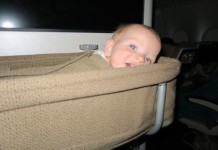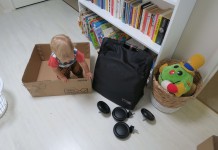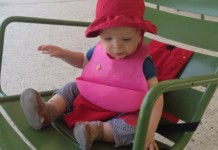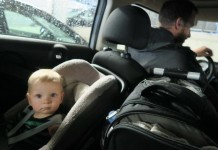Bassinets. Bulkhead. All airlines are not created equal and some are known as more being more family friendly than others. When you are flying with an infant, look for airlines that will let you bring pram to gate, or have specific programs, like Etihad’s flying nanny service, reviewed by Sue here.
3 key things to remember when flying with an infant.
1. Pack smart.
It goes without saying that you’ll probably want to be armed with spare nappies, spare clothes for the baby (even more if they are a vomiter), and don’t forget, spare clothes for you. Ziplock bags are handy, a few toys are also good once they hit a certain age (see our advice for different age brackets below), but overall, don’t overpack. In our packing post we talk about our favourite carry on luggage for flying with an infant – a rolling backpack.
2. Check-in early.
Firstly, this is your best chance of securing a bassinet or troubleshooting if your request for one didn’t come through – see below. But it is also a good chance to ask if they can “block out” the seat next to you, or if you are travelling with a friend or family member, the seat between you. Some airlines will do this as a matter of course when they see you travelling with an infant, others will do it if you ask and there’s space available. Having that extra space really makes a difference, although of course, it’s a privilege as you haven’t paid for it. (Under ones tend to travel long haul for free, but the exchange is that they sit on your lap, or hopefully, sleep in that much-prized bassinet. Pricing kicks in when you decide to buy them a seat or they hit two years old – whichever comes first.)
3. Move mountains to get a bassinet.
Regardless of their age, if they’re under one, or a small baby, try to move mountains to get them the bassinet. These are provided by almost every airline on long-haul flights, however allocations are done differently according to each airline (although most have a policy that the younger babies get preference). Some allocate bassinets at the time of booking, so make sure your travel agent confirms this has been requested. If you’ve booked online, immediately call the airline and speak to someone to add the request your booking. If it turns out that you don’t get a bassinet, or, worse, that you’re not allocated the bulkhead row (the one where there’s a bit more legroom, which offers some options for your baby to play on the floor) then just keep asking. Ask on check-in. Ask while you’re waiting at the departure gate. Ask the minute you step on board. You get it; just keep asking. Many airlines will then make it happen, even if it involves asking other passengers to move. (Yes, this is very nice of the other passengers, and one time that you should certainly accept the kindness of strangers.)
Tips for long-haul flying with an infant from O-5 months.
This is the easiest age for flying with an infant. Baby will basically do their own thing, which typically includes quite a lot of sleeping. Make sure you take a carrier (like an Ergo) in case you want to walk up and down the aisle. (Remember that you’ll have to take the baby out of this as you go through security, so try and time that experience for when the baby is awake).
If you are exclusively breastfeeding at this point, food and liquid for the baby is taken care of. If you are using bottles or formula, most airlines are pretty good at letting you store things in the fridge, or heating up bottles in a microwave. Be warned, there have been some stories of airline security making sleep-deprived mothers throw out their hard earned expressed milk. This is not supposed to happen, but would obviously be heartbreaking and a real problem if it did; perhaps talk to your specific airline in advance just confirm the policy in terms of the destinations you are travelling to and from.
Tips for long-haul flying with an infant from 5-8 months.
You may still be in the sweet spot for flying with an infant. Your baby probably still sleeps quite a lot, and if they are eating solids it may be partly or all purees, which you can easily take with you. There are plenty of organic and preservative-free options on the market, meaning that you still get quite good control over what goes in your child’s mouth on a long flight.
Babies are also reasonably easily entertained during this stage. But you’d do well to take a couple of favourite toys (we love the Skwish), any special “blankeys”, and if theyare used to sleeping in a sleeping bag, take extras in case of leaks. The real shift comes when your baby is more mobile: if you’ve got an early crawler you’ll want to use some of the tips for the 9-12 month olds, and be prepared to spend a lot of time letting them roam supervised up and down the aisles. (Not a bad thing really: at least you’re unlikely to get DVT!)
Tips for long-haul flying with babies from 9-12 months.
Your baby is still definitely a baby, but is starting to have some of the needs of a wriggly toddler. He’ll be unlikely to be content to sit still for too long; will probably have particular times of the day that he’ll sleep (or not sleep); and will need some fairly intensive entertaining. It’s the latter that most parents worry about.
There are a couple of great ideas we’ve seen used to entertain a baby on a plane; of course take a few favourite toys, but it may be smarter to unveil a couple of new ones in flight. Another clever trick which Sue has used successfully is to head to your local two dollar store and buy 5-10 small but “interesting-to-a-small-person” trinkets. Wrap each of them individually, and pull out one by one at strategic points during the flight.
Stuck for ideas? Here are two of our favourites: Various pieces of coloured and sparkly ribbons, tied together with the various colours as one long thread, and those soft balls for scrubbing your body with in the shower. Basically you’re after anything that’s particularly squashy, colourful or has an interesting texture. Probably try and stay away from noisy things, as it’s nice to keep your fellow passengers on side.
Speaking of other passengers, while it’s true no one loves sitting next to a crying baby (including its parents, ha ha), many other passengers on the flight will quite enjoy a chance to goo, ga and generally engage with your baby for five minutes as you stroll down the aisle. It doesn’t sound like much of the solve, until you realise that long haul flights have a lot of passengers on them – you can stretch out that walk down the aisle for about an hour a time in this way. The people who are not interested will be pretty obvious – they’re the ones who aren’t making eye contact and smiling as you follow your crawling or cruising bub at snail’s pace along the skinny aisle.
For all ages: a stopover can really help save your sanity, and preserve your stamina. These are highly recommended on long haul flights, see our stopover post for more.
If you’re not having a stopover, investing in an airport lounge day pass can be a fantastic way to boost your energy levels in transit. Learn more about this option here.










































[…] plane trips are never as bad as you imagine they will be. (See our tips on flying long haul and short haul […]